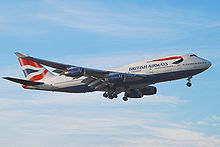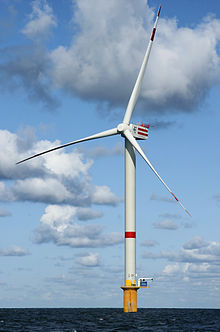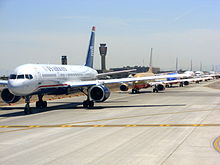- Mitigation of aviation's environmental impact
-
Aviation has an impact on the environment due to aircraft engines emitting noise, particulates, and gases which contribute to climate change[1][2] and global dimming.[3] Despite emission reductions from automobiles and more fuel-efficient (and therefore less polluting) turbofan and turboprop engines, the rapid growth of air travel in recent years contributes to an increase in total pollution attributable to aviation. In the EU, greenhouse gas emissions from aviation increased by 87% between 1990 and 2006.[4]
At present aviation accounts for 2% of global CO2 emissions and this is projected by the IPCC to rise to 3% by 2050. [5] This presents the operators of aircraft with a responsibility to reduce emissions.
Contents
Methods of mitigating aviation’s CO2 emissions
Mitigation of aviation's environmental impact can be achieved through a variety of measures, the most obvious and arguably the most economical of which is to reduce the fuel burn of the aircraft as this accounts for 28% of an airlines costs. However there is a wide variety of other options available to minimise aviation's growing impact upon the environment as are listed below [5]:
Aircraft efficiency
 The Boeing 787 Dreamliner promises to provide 20% lower fuel burn than current-generation aircraft.
The Boeing 787 Dreamliner promises to provide 20% lower fuel burn than current-generation aircraft.
As stated previously, reducing the direct fuel burn of an aircraft is the most obvious and arguably the most economical way of reducing emissions attributable to aviation. Over the last 40 years, commercial jet airliners have become 70% more fuel efficient and are predicted to be another 25% more fuel efficient by 2025.[5]
The next-generation of aircraft, including the Boeing 787 Dreamliner, Airbus A350 and Bombardier CSeries, are 20% more fuel efficient per passenger kilometre than current generation aircraft. This is primarily achieved through more fuel-efficient engines and lighter airframes & supporting structures made of composite materials but is also achieved through more aerodynamic shapes, winglets, a "one-piece" fuselage and more advanced computer systems for optimising routes and loading of the aircraft. [6]
Route optimization
Currently, air traffic corridors that aircraft are forced to follow place unnecessary detours on an aircraft's route forcing higher fuel burn and an increase in emissions. An improved Air Traffic Management System with more direct routes and optimized cruising altitudes would allow airlines to reduce their emissions by up to 18%.[5]
In the European Union, a Single European Sky has been proposed for the last 15 years so that there are no overlapping airspace restrictions between countries in the EU and so reduce emissions. As of yet, the Single European Sky is still only a plan but progress has been made. If the Single European Sky had been created 15 years ago, 12 million tons of CO2 could have been saved.[5]
Biofuels
 British Airways will be using half a million tonnes of waste annually to create biofuels for commercial use from 2014 onwards.
British Airways will be using half a million tonnes of waste annually to create biofuels for commercial use from 2014 onwards.
Biofuels are fuels derived from biomass material such as plants and waste. Plant derived biofuels offer large savings in CO2 emissions as they absorb Carbon Dioxide and release it as Oxygen when they grow and so in a life-cycle, emissions can be drastically reduced. A number of airlines have operated biofuel test flights including Virgin Atlantic Airways, which flew with one engine operating on a blend of 20% coconut oil and 80% traditional jet fuel, and Continental Airlines which flew with one engine operating on a blend of 44% Jatropha oil, 6% Algae oil and 50% traditional jet fuel. Other airlines to demonstrate biofuels include Air New Zealand and Japan Airlines.[7]
In the Continental Airlines test, the engine running partly on biofuel burned 46 kg less fuel than the conventionally fuelled engine in 1 and a half hours while producing more thrust from the same volume of fuel. Continental Airlines' CEO, Larry Kellner, commented "This is a good step forward, an opportunity to really make a difference to the environment" citing jatropha's 50-80% lower CO2 emissions as opposed to Jet-A1 in its lifecycle.[7]
From 2014 onwards, British Airways, in co-operation with Solena, is going to turn half a million tonnes of waste annually that would normally go to landfill from the City of London into biofuel to be used in the British Airways fleet. Waste derived biofuel produces up to 95% less pollution in its life-cycle and so therefore this measure will reduce emissions by the equivalent of taking 42,000 cars off the road every year. [8]
Improved operating procedures
 Scandinavian Airlines is operating their 737 aircraft at slower cruising speeds to reduce emissions by 7-8%.
Scandinavian Airlines is operating their 737 aircraft at slower cruising speeds to reduce emissions by 7-8%.
Airlines and airports are looking at ways of reducing emissions and fuel burn through the use of improved operating procedures. Two of the more common ones in operation are a single-engine taxi to and from the runway and the use of a Continuous Descent Approach, or CDA, which can reduce emissions significantly during the operations in and around an airport.[9] Scandinavian Airlines (SAS) is now operating its Boeing 737 fleet at a slower cruising speed to help reduce emissions by 7-8%.[10]
Emission Trading Scheme
In the EU, aviation will be including the European Emission Trading Scheme from 2012 onwards. The scheme places a cap on the emissions an aircraft operator can emit and forces the operator to either lower emissions through more efficient technology or to buy "Carbon Credits" from other companies who have produced fewer emissions than their cap. It is thought that this will reduce aviation's net environmental impact.[4]
Methods of mitigating aviation’s non-CO 2 emissions
Aviation produces a number of other pollutants besides carbon dioxide including nitrogen oxides (NOX), particulates, unburned hydrocarbons (UHC) and contrails. A number of methods to reduce the level of these pollutants follows:
Nitrogen oxides (NOX)
Nitrogen oxides have a far stronger impact upon climate change than Carbon Oxides and are produced in small quantities from aircraft engines. Engine designers have worked since the start of the jet age to reduce NOX emissions and the result is ever reducing levels of nitrogen oxide emissions. For example, between 1997 and 2003, NOX emissions from jet engines fell by over 40%.[11]
Particulates
Particulates and smoke were a problem with early jet engines at high power settings but modern engines are designed so that no smoke is produced at any point in the flight.[11]
Unburned hydrocarbons (UHC)
Unburned hydrocarbons (UHC) are products of incomplete combustion of fuel and are produced in greater quantities in engines with low pressure gains in the compressors and/or relatively low temperatures in the combustor. As with particulates, UHC has all but been eliminated in modern jet engines through improved design and technology.[11]
Contrails
Aircraft flying at high altitude form condensation trails or contrails in the exhaust plume of their engines. While in the Troposphere these have very little climatic impact. However, jet aircraft cruising in the Stratosphere do create an impact from their contrails, although the extent of the damage to the environment is as yet unknown. Contrails can also trigger the formation of high-altitude Cirrus cloud thus creating a greater climatic effect.[11]
In the three days following the September 11 Attacks on the World Trade Center in New York City, when no commercial aircraft flew in the USA, climate scientists measured the daily temperature range over 5000 weather stations across the USA. The results showed a 1 ° Celsius change in the average daily temperature range for those days of the year, thus showing contrails do have a significant impact on climate.[3] Potential ways of reducing the impact of contrails on our climate include reducing the maximum cruising altitude of aircraft so high-altitude contrails can not form. Cruising at lower altitudes would marginally increase flight time and increase fuel consumption by 4%.[12]
Methods of mitigating aviation's noise emissions
Main article: Aircraft noise Serrated edges of the nacelle on the Rolls-Royce Trent 1000 fitted to the new Boeing 787 Dreamliner "Dreamliner".
Serrated edges of the nacelle on the Rolls-Royce Trent 1000 fitted to the new Boeing 787 Dreamliner "Dreamliner".
One of the by-products of an aircraft's engine is noise and this has become an increasingly important issue which is being dealt with through many different methods:
Engines
Next-Generation engines are not only more fuel-efficient but also tend to be quieter with Pratt & Whitney's PurePower PW1000G fitted to the Bombardier CSeries aircraft being 4 times quieter than aircraft currently in service.[13] Engines can also incorporate serrated edges on the back of the nacelle to reduce noise impact as shown in this picture.[11]
Improved operating procedures
A Continuous Descent Approach, or CDA, not only reduces fuel burn but also allows airlines to provide quieter approaches for part of the descent to a runway. As the engines are at close to idle power, less noise emissions are produced and combined with new engine technology, the reductions in noise emissions can be large.[9]
Carbon offset
 Money generated by carbon offsets from airlines often go to fund green-energy projects such as wind farms.
Money generated by carbon offsets from airlines often go to fund green-energy projects such as wind farms.
A carbon offset is a means of reducing emissions to zero by saving enough carbon to balance the carbon emitted by a particular action. Several airlines have begun offering carbon offsets to passengers to offset the emissions created by their proportion of the flight. Money generated is put to projects around the world to invest in green technology such as renewable energy and research into future technology. Airlines offering carbon offsets include British Airways, easyJet, Continental Airlines, Delta Air Lines, Lufthansa and Qantas although there are many more carriers participating in such schemes.[14][15][16][17]
British Airways' scheme
British Airways' carbon offsetting scheme involves paying a fee dependant on aircraft type, class of travel and distance flown and therefore prices vary. Funds generated are currently awarded to three renewable energy projects around the world: Bayin'aobao wind farm in Inner Mongolia, Faxinal dos Guedes hydroelectric power plant in Brazil and Xiaohe hydroelctric power plant in Gansu Province, China.[18]
Continental Airlines' scheme
Continental Airlines' carbon offsetting scheme involves paying a fixed fee of $2 to cancel out emissions through reforestation. Passengers can also choose to pay $50 for offsetting emissions through renewable energy projects.[17]
See also
- Air transport and the environment (United Kingdom)
- Environmental impact of aviation
- Hypermobility
References
- ^ International Civil Aviation Organization, Air Transport Bureau (ATB) (undated). "Aircraft Engine Emissions". http://www.icao.int/icao/en/env/aee.htm. Retrieved 2010-05-01.
- ^ Enviro.aero (undated). "What is the impact of flying?". http://www.enviro.aero/Impactofflying.aspx. Retrieved 2010-05-01.
- ^ a b Travis, David J. (2002). "Contrails reduce daily temperature range". Nature 418 (6898): 601. doi:10.1038/418601a. PMID 12167846. http://facstaff.uww.edu/travisd/pdf/jetcontrailsrecentresearch.pdf.
- ^ a b "Climate change: Commission proposes bringing air transport into EU Emissions Trading Scheme" (Press release). EU press release. 2006-12-20. http://europa.eu/rapid/pressReleasesAction.do?reference=IP/06/1862. Retrieved 2010-05-01.
- ^ a b c d e New York Times - Aviation and global warming, New York Times, 2007-9-20, http://www.nytimes.com/2007/09/20/opinion/20iht-edbisi.1.7583290.html, retrieved 2010-05-01
- ^ Boeing 787 Technology, Boeing, http://www.boeing.com/commercial/787family/background.html, retrieved 2010-05-01
- ^ a b "A Greener Future?" - Aircraft Illustrated, March 2009
- ^ Solena Video on British Airways biofuel usage, Solena, http://www.cleanskies.com/videos/british-airways-solena-work-develop-europes-first-sustainable-jet-fuel-plant, retrieved 2010-05-01
- ^ a b CDA Information, Civil Aviation Authority (UK), http://www.caa.co.uk/docs/68/Basic_Principles_CDA.pdf, retrieved 2010-05-01
- ^ SAS reduces cruising speed to reduce emissions, Allianz, http://knowledge.allianz.com/en/globalissues/energy_co2/climate_solutions/aviation_emissions_reduction.html, retrieved 2010-05-01
- ^ a b c d e Rolls-Royce - The Jet Engine - ISBN 0 902121 2 35
- ^ Williams, Victoria; Robert B. Nolanda and Ralf Toumib (November 2002). "Reducing the climate change impacts of aviation by restricting cruise altitudes". Transportation Research Part D: Transport and Environment 7 (6): 451–464. doi:10.1016/S1361-9209(02)00013-5. http://www.sciencedirect.com/science?_ob=ArticleURL&_udi=B6VH8-461XGG5-2&_user=2717328&_rdoc=1&_fmt=&_orig=search&_sort=d&view=c&_acct=C000056831&_version=1&_urlVersion=0&_userid=2717328&md5=b533e05b2465b167cfb5a88c4fa0cbff. Retrieved 2010-05-02.
- ^ Bombardier CSeries Statistics, Bombardier, http://www.bombardier.com/en/aerospace/products/commercial-aircraft/cseries?docID=0901260d800091e6, retrieved 2010-05-01
- ^ British Airways Carbon Offset Programme, British Airways, http://www.britishairways.com/travel/csr-your-footprint/public/en_gb, retrieved 2010-05-02
- ^ easyJet Carbon Offset Programme, easyJet, http://www.easyjet.com/EN/Environment/index.shtml, retrieved 2010-05-02
- ^ Continental Airlines Carbon Offset Programme, Continental Airlines, http://www.continental.com/web/en-US/content/company/globalcitizenship/offset.aspx, retrieved 2010-05-02
- ^ a b Continental Airlines Carbon Offset Schemes, Bloomberg, http://www.businessweek.com/bwdaily/dnflash/content/mar2008/db20080321_437700.htm, retrieved 2010-05-02
- ^ British Airways Carbon Offset Schemes, British Airways, http://www.britishairways.com/travel/csr-projects/public/en_gb, retrieved 2010-05-02
External links
Lists relating to aviation General Aircraft (manufacturers) · Aircraft engines (manufacturers) · Airlines (defunct) · Airports · Civil authorities · Museums · Registration prefixes · Rotorcraft (manufacturers) · TimelineMilitary Accidents/incidents Records Categories:
Wikimedia Foundation. 2010.


